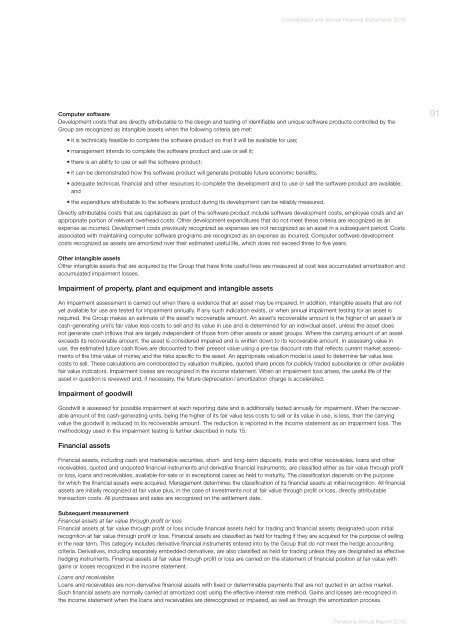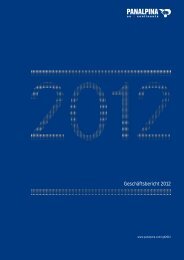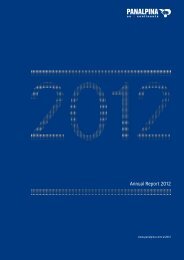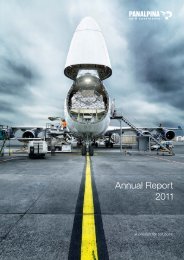Annual Report 2010 (PDF, 5.2MB) - Panalpina Annual Report 2012
Annual Report 2010 (PDF, 5.2MB) - Panalpina Annual Report 2012
Annual Report 2010 (PDF, 5.2MB) - Panalpina Annual Report 2012
Create successful ePaper yourself
Turn your PDF publications into a flip-book with our unique Google optimized e-Paper software.
Consolidated and <strong>Annual</strong> Financial Statements <strong>2010</strong><br />
Computer software<br />
Development costs that are directly attributable to the design and testing of identifiable and unique software products controlled by the<br />
Group are recognized as intangible assets when the following criteria are met:<br />
91<br />
• it is technically feasible to complete the software product so that it will be available for use;<br />
• management intends to complete the software product and use or sell it;<br />
• there is an ability to use or sell the software product;<br />
• it can be demonstrated how the software product will generate probable future economic benefits;<br />
• adequate technical, financial and other resources to complete the development and to use or sell the software product are available;<br />
and<br />
• the expenditure attributable to the software product during its development can be reliably measured.<br />
Directly attributable costs that are capitalized as part of the software product include software development costs, employee costs and an<br />
appropriate portion of relevant overhead costs. Other development expenditures that do not meet these criteria are recognized as an<br />
expense as incurred. Development costs previously recognized as expenses are not recognized as an asset in a subsequent period. Costs<br />
associated with maintaining computer software programs are recognized as an expense as incurred. Computer software development<br />
costs recognized as assets are amortized over their estimated useful life, which does not exceed three to five years.<br />
Other intangible assets<br />
Other intangible assets that are acquired by the Group that have finite useful lives are measured at cost less accumulated amortization and<br />
accumulated impairment losses.<br />
Impairment of property, plant and equipment and intangible assets<br />
An impairment assessment is carried out when there is evidence that an asset may be impaired. In addition, intangible assets that are not<br />
yet available for use are tested for impairment annually. If any such indication exists, or when annual impairment testing for an asset is<br />
required, the Group makes an estimate of the asset’s recoverable amount. An asset’s recoverable amount is the higher of an asset’s or<br />
cash-generating unit’s fair value less costs to sell and its value in use and is determined for an individual asset, unless the asset does<br />
not generate cash inflows that are largely independent of those from other assets or asset groups. Where the carrying amount of an asset<br />
exceeds its recoverable amount, the asset is considered impaired and is written down to its recoverable amount. In assessing value in<br />
use, the estimated future cash flows are discounted to their present value using a pre-tax discount rate that reflects current market assessments<br />
of the time value of money and the risks specific to the asset. An appropriate valuation model is used to determine fair value less<br />
costs to sell. These calculations are corroborated by valuation multiples, quoted share prices for publicly traded subsidiaries or other available<br />
fair value indicators. Impairment losses are recognized in the income statement. When an impairment loss arises, the useful life of the<br />
asset in question is reviewed and, if necessary, the future depreciation / amortization charge is accelerated.<br />
Impairment of goodwill<br />
Goodwill is assessed for possible impairment at each reporting date and is additionally tested annually for impairment. When the recoverable<br />
amount of the cash-generating units, being the higher of its fair value less costs to sell or its value in use, is less, then the carrying<br />
value the goodwill is reduced to its recoverable amount. The reduction is reported in the income statement as an impairment loss. The<br />
methodology used in the impairment testing is further described in note 15.<br />
Financial assets<br />
Financial assets, including cash and marketable securities, short- and long-term deposits, trade and other receivables, loans and other<br />
receivables, quoted and unquoted financial instruments and derivative financial instruments, are classified either as fair value through profit<br />
or loss, loans and receivables, available-for-sale or in exceptional cases as held to maturity. The classification depends on the purpose<br />
for which the financial assets were acquired. Management determines the classification of its financial assets at initial recognition. All financial<br />
assets are initially recognized at fair value plus, in the case of investments not at fair value through profit or loss, directly attributable<br />
transaction costs. All purchases and sales are recognized on the settlement date.<br />
Subsequent measurement<br />
Financial assets at fair value through profit or loss<br />
Financial assets at fair value through profit or loss include financial assets held for trading and financial assets designated upon initial<br />
recognition at fair value through profit or loss. Financial assets are classified as held for trading if they are acquired for the purpose of selling<br />
in the near term. This category includes derivative financial instruments entered into by the Group that do not meet the hedge accounting<br />
criteria. Derivatives, including separately embedded derivatives, are also classified as held for trading unless they are designated as effective<br />
hedging instruments. Financial assets at fair value through profit or loss are carried on the statement of financial position at fair value with<br />
gains or losses recognized in the income statement.<br />
Loans and receivables<br />
Loans and receivables are non-derivative financial assets with fixed or determinable payments that are not quoted in an active market.<br />
Such financial assets are normally carried at amortized cost using the effective interest rate method. Gains and losses are recognized in<br />
the income statement when the loans and receivables are derecognized or impaired, as well as through the amortization process.<br />
<strong>Panalpina</strong> <strong>Annual</strong> <strong>Report</strong> <strong>2010</strong>






